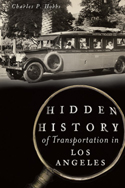The California Railroad Commission was formed in 1911 to regulate railroads. In 1912 it was empowered to regulate other public utilities such as electric companies, water companies and gas companies. Regulation of buses and trucks started in May 1917. In 1943, the Railroad Commission was renamed the Public Utilities Commission.
The Commission maintains jurisdiction over private bus lines serving more than one city.
(Bus companies operating entirely within one city are not subject to the Commission rules.) For the most part, Commission jurisdiction over publicly-owned transit agencies (such as Los Angeles Metro or San Francisco Muni) is limited. However, the Commission does regulate highway-railroad grade crossings, and the safety of all rail transit systems in California, from Angels Flight to BART.
When a bus operator wanted to add, delete or change a route, or raise fares, it would have to file with the Commission, which would make a decision as to whether or not to allow the change. These decisions are listed in books labeled “Decisions of the Railroad / Public Utilities Commission.” Dates and volumes are as follows:
V1 (Jan 1, 1911) to V46 (Aug 28, 1945) (under old CRC name, first series)
V47 (Nov 15, 1946) to V84 (May 2 1978) (CPUC, first series)
V1 (Dec 12, 1978) to V86 (Apr 1, 1999) – second series (red label)
V1 (June 1999) to V8 (Sept 7, 2000) – third series (blue label)
Decisions from July 2000 onward are available online at http://docs.cpuc.ca.gov/cyberdocs/webQuickStart.asp?SearchID=2
For most transportation historians, the first series is probably most interesting. This covers the years from the early streetcar, jitney and intercity “motor stage lines,” up until the last of the pirate companies were acquired by public transit agencies. Later volumes deal more with airport shuttles, limos, or even airlines (until deregulation in the late 1970s).
The 1911-1922 books are available as full text through Google Books. (Search “Decisions of the California Railroad Commission.”) The Commission, however, did not regulate highway transportation until May 1917, so start looking there for information on early bus lines.
From 1923 onward, most larger law libraries in California have at least some of the volumes. The Los Angeles County Law Library has all of the volumes in closed stacks; these can be requested from the counter staff. Be sure to specify both volume and series when requesting volumes.
UCLA and USC have nearly full sets in their law libraries as well. These are on open shelves (USC uses a movable shelving system). Beware of restricted access, especially around law school exam time. Volumes are also available at the Southern Regional Library Facility (SRLF) at UCLA, either in person (long walk!) or by requesting them at any campus library (takes a couple of days).
Other county law libraries should have these volumes, although their sets tend to be incomplete.
Flip through the books or use the indexes (several of the volumes have separate indexes for “Automobile Stage” or “Passenger Stages”).
Although all of the Commission’s decisions are referenced, not all are actually printed in full in the volumes. Copies of any decision not printed in full can be obtained by writing to the Commission at the following address:
Public Utilities Commission
State of California
505 Van Ness Avenue
San Francisco, CA 94102
There is a twenty-cent per page copying charge, which will be invoiced separately. Decisions range from one to six pages. Be aware that large orders (more than one or two decisions) may take several weeks to complete.
Other options include visiting the Commission offices in person, or searching for decisions and other Commission materials in library collections. Try a search on Worldcat or in the Online Archive of California.

Leave a Reply